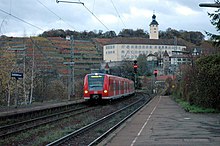
The Neckar is a 362-kilometre-long (225 mi) river in Germany, mainly flowing through the southwestern state of Baden-Württemberg, with a short section through Hesse. The Neckar is a major right tributary of the Rhine. Rising in the Schwarzwald-Baar-Kreis near Schwenningen in the Schwenninger Moos conservation area at a height of 706 m (2,316 ft) above sea level, it passes through Rottweil, Rottenburg am Neckar, Kilchberg, Tübingen, Wernau, Nürtingen, Plochingen, Esslingen, Stuttgart, Ludwigsburg, Marbach, Heilbronn and Heidelberg, before discharging on average 145 m3/s (5,100 cu ft/s) of water into the Rhine at Mannheim, at 95 m (312 ft) above sea level, making the Neckar its 4th largest tributary, and the 10th largest river in Germany. Since 1968, the Neckar has been navigable for cargo ships via 27 locks for about 200 kilometres (120 mi) upstream from Mannheim to the river port of Plochingen, at the confluence with the Fils.
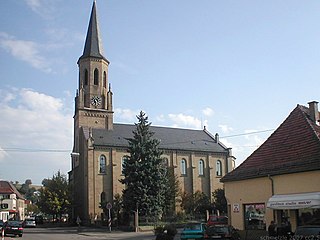
Meckesheim is a village in south western Germany. It is located between Heidelberg and Sinsheim in the Rhein-Neckar district in the state of Baden-Württemberg.

The Rhine-Neckar S-Bahn(S-Bahn RheinNeckar) forms the backbone of the urban rail transport network of the Rhine Neckar Area, including the cities of Mannheim, Heidelberg and Ludwigshafen.
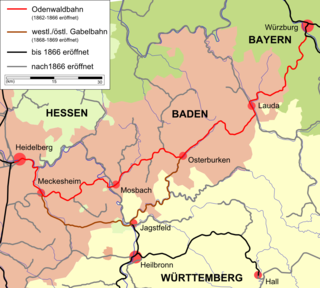
The Odenwald Railway was the name given to a Baden railway line in southwestern Germany built from between 1862 and 1866. It ran from Heidelberg via Neckargemünd and Meckesheim through the Little Odenwald mountains to Waibstadt, Mosbach, Osterburken and Lauda to Würzburg in Bavaria.

The Meckesheim–Neckarelz railway is a branch line in northern Baden between Meckesheim and Aglasterhausen that used to run to Neckarelz. It was part of the former Baden Oldenwald Railway from Heidelberg to Würzburg, and thus a main line, which is why its trackbed was built for two tracks. The section remaining today also goes under the name of Schwarzbach Valley Railway.
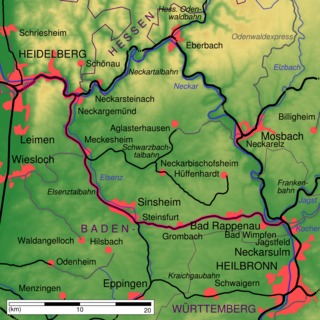
The Elsenz Valley Railway (Elsenztalbahn) or Neckargemünd–Bad Friedrichshall railway is an electrified, partly double-tracked main line in the German state of Baden-Württemberg, running from Heidelberg via Sinsheim to Bad Friedrichshall, that, for part of its course, follows the Elsenz river that gives it its name. The crossing stations on the single-tracked sections were controlled by mechanical signal boxes until 2008, but are now controlled by electronic interlockings.

The Franconia Railway is a 180-kilometre-long (110 mi) railway line in the north of the German state of Baden-Württemberg and the Bavarian province of Lower Franconia that links Stuttgart and Würzburg. Its name comes from the fact that the majority of the line runs through Franconia. The first section of the line was opened in 1848 and is one of the oldest lines in Germany. The main line is now electrified and has been almost entirely upgraded to double-tracks.

Heilbronn Hauptbahnhof is the main passenger railway station in Heilbronn in the German state of Baden-Württemberg.

Bad Friedrichshall Hauptbahnhof is a regionally important junction station and a former border station in the city of Bad Friedrichshall in the German state of Baden-Württemberg. The modern Elsenz Valley Railway and Neckar Valley Railway branch from the Franconia Railway here. Until 1993 it was the starting point of the Lower Kocher Valley Railway.

The Neckarelz–Osterburken railway is a 30.9 km long railway line in the north of the German state of Baden-Württemberg, which connects the Neckar and the Bauland along the edge of the Odenwald. It was opened in 1866 as part of the Odenwald Railway (Baden) (Odenwaldbahn) between Heidelberg and Würzburg. It has been upgraded to form an entirely double-track and electrified main line railway. It was an east–west axis for German long-distance transport until 1945. Since 2003 passenger services on it have been operated by the Rhine-Neckar S-Bahn. The Neckarelz–Mosbach section has also been served by the Heilbronn Stadtbahn since 2014.

The Steinsfurt–Eppingen railway, which opened in 1900, is a 12.9 km long, single-track and electrified branch line along the Elsenz river in the Kraichgau region of the German state of Baden-Württemberg, between the Sinsheim district of Steinsfurt and Eppingen, connecting the Elsenz Valley Railway and the Kraichgau Railway. Since 2006, the Baden-Württemberg Regional Transport Company has marketed the line as the Kraichgau–Stromberg Railway. The line is part of line S5 of the Rhine-Neckar S-Bahn, opened between Heidelberg and Eppingen on 12 December 2009.

Wiesloch-Walldorf station is in the towns of Wiesloch and Walldorf in the German state of Baden-Württemberg. The station is classified by Deutsche Bahn as a category 3 station. Leimbach Park and the Wiesloch Feldbahn and Industrial Museum are located to the north of the station, with the headquarters of Heidelberger Druckmaschinen and SAP SE on the south-western side.

Sinsheim (Elsenz) Hauptbahnhof — called Sinsheim (Elsenz) station until 2010 — is a station on the Neckargemünd–Bad Friedrichshall-Jagstfeld railway in the German state of Baden-Württemberg. The station falls within the area of the Verkehrsverbund Rhein-Neckar and is an important station in the Kraichgau. In the area of the city of Sinsheim, there are also stations at Hoffenheim, Sinsheim Museum/Arena, Steinsfurt and Reihen.

The Heilbronn Stadtbahn is a three line tram-train system in city of Heilbronn in the German state of Baden-Württemberg. It is based on the Karlsruhe model and operated jointly by the Albtal-Verkehrs-Gesellschaft (AVG), the Stadtwerke Heilbronn (SWH) and Deutsche Bahn (DB). It operates on normal railways under the Eisenbahn-Bau- und Betriebsordnung and within Heilbronn under the Verordnung über den Bau und Betrieb der Straßenbahnen.

Osterburken station is at the junction of the Franconia Railway and the Neckarelz–Osterburken railway. It is served by Regionalbahn, Regional-Express and Rhine-Neckar S-Bahn services.

Mosbach (Baden) station is, along with Mosbach-Neckarelz and Mosbach West, one of three stations in the Baden town of Mosbach in the district of Neckar-Odenwald-Kreis. It is located at kilometre 53.4 of the Neckarelz–Osterburken railway. It was opened for the Landesgartenschau of 1997 as a replacement for the old Mosbach station close to Mosbach's old town.

Bad Rappenau station is the station of Bad Rappenau, a spa town in the German state of Baden-Württemberg. It is located at kilometre 27.9 on the Elsenz Valley Railway (Elsenztalbahn) or Neckargemünd–Bad Friedrichshall railway and is classified by Deutsche Bahn as a category 5 station.

Meckesheim station is a small railway junction in Meckesheim, North Baden in the German state of Baden-Württemberg. It is located on the Neckargemünd–Bad Friedrichshall railway and is classified by Deutsche Bahn as a category 4 station. The Schwarzbach Valley Railway branches off the Elsenz Valley Railway to Aglasterhausen in Meckesheim. Until 1990, the Wiesloch–Meckesheim/Waldangelloch railway also branched off via Schatthausen to Wiesloch Stadt and Wiesloch-Walldorf.
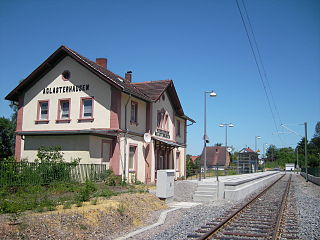
Aglasterhausen station is the terminus of the Meckesheim–Neckarelz railway in Aglasterhausen in the German state of Baden-Württemberg. It has one platform and is located in the network administered by the Verkehrsverbund Rhein-Neckar (VRN). It is classified by Deutsche Bahn as a category 7 station.

Bad Wimpfen station is a station in a station in the spa town of Bad Wimpfen in the German state of Baden-Württemberg. It is at the kilometre 33.8 point on the Elsenz Valley Railway. It is classified by Deutsche Bahn as a category 6 station. The station building is heritage-listed.



